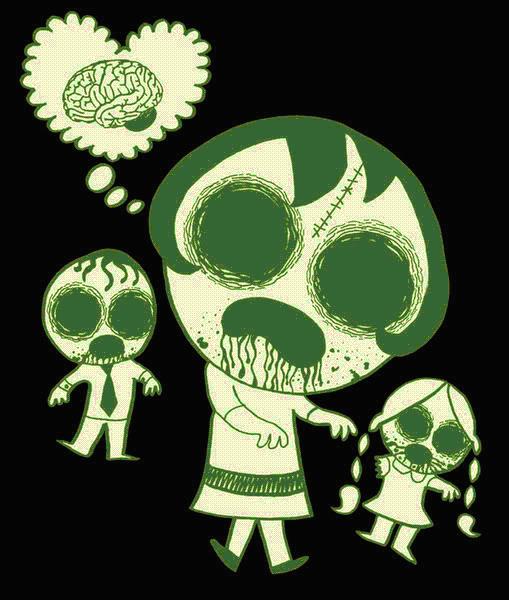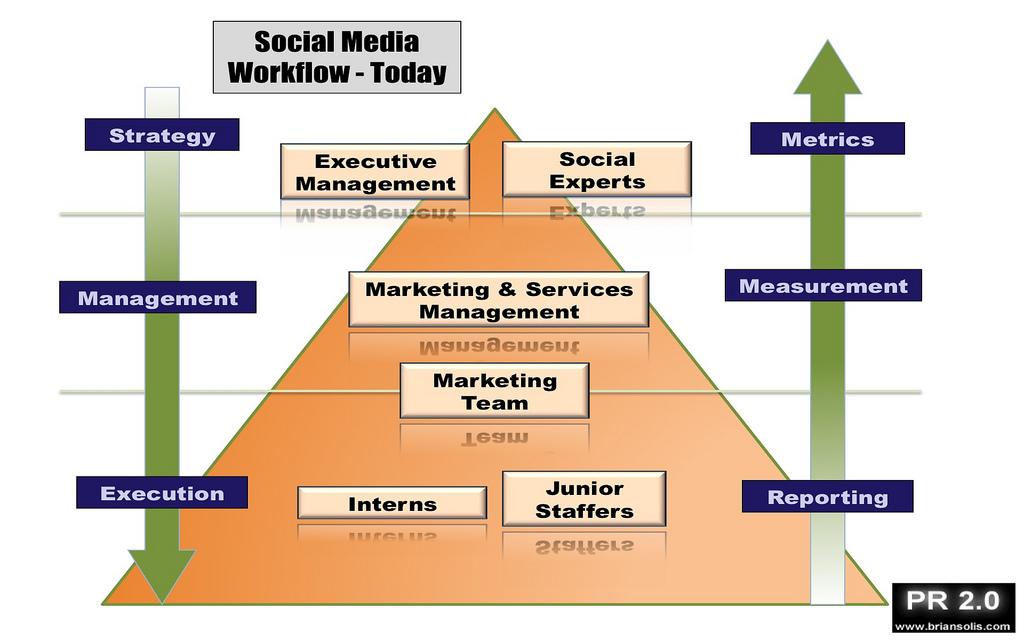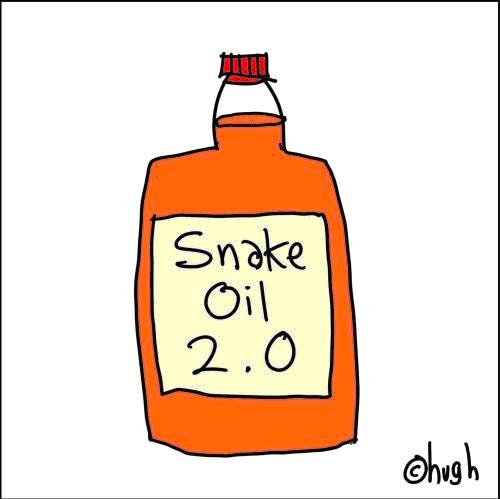This post is long. If you prefer a Word or PDF version, please click here to download: “The State of PR, Marketing and Communications.”
Please take your time … Read it. Breathe it in. Live the change you wish to see.
 Source
Source
Modern public relations was born in the early 1900s, although history traces its roots and origins of practice back to the 17th century. Two years ago, the press release celebrated its 100-year anniversary.
While the communications industry has iterated with every new technological advancement over the last century, including broadcast media and Web 1.0, none, however, have forced complete transparency prior to the proliferation of the Read/Write Web, aka The Social Web, aka Web 2.0.
It is this element of fundamental transparency of social media, combined with its sheer expansiveness and overwhelming potential, that is both alarming and inspiring public relations professionals everywhere. At the minimum, it’s sparking new dialogue, questions, education and innovation, and also forcing the renaissance of the aging business of public relations itself.
While some are already predicting the death of public relations, I fundamentally believe that it’s simply the death of public relations as we know it. As long as communications professionals want to learn and improve their craft, then we are positioned for evolution. No matter how much we think we know, we’re now equalized as an industry in order to reset, learn, and define and earn an invaluable role within the business cycle — again.
Contrary to popular belief, social media isn’t killing public relations, but the business of public relations IS in a state of paramount crisis. It’s not without merit however. Perhaps up until now we have been our own worst enemy.
The social Web, the democratization of content and the wisdom of the crowds is merely amplifying public relations’ weaknesses and expediting the declination of a broken business model. As it is, many of us are collectively contributing to its perceived insignificance and irrelevance.
But there’s hope. And that hope is you …
Our future lies in our ability to shift “PR” from a business of publicity to a regimen of true “public” relations.
Abbreviating “PR” truncates the value of our role in one of the greatest transformations the communications industry has ever witnessed.
As good friend Nicole Jordan told me over dinner in NY recently, “PR stands for press release, not public relations. When people ask me what I do, I tell them that I’m in integrated communications. Public relations today is about much more than press releases and pitching, and I am so much more than just a PR person.”
Indeed. Just ask any executive what comes to mind when you say “PR,” and note the common misperception shared by many decision makers.
The brutally honest responses, whether you agree or not, will represent more than we’d care to know or acknowledge. The assessments and responses will most likely span from “publicist” to “networker” to “press release” to some fallaciously degrading and sexist stereotypes of what “PR” people are, how they act and what they look like. You’ll also summon war stories and bad experiences with “PR” people and agencies that unfortunately continue to reinforce the current state of the public relations crisis for the public relations industry in general.
There are reasons we are where we are, and unfortunately, the public relations industry hasn’t hired a crisis communications team to alter or steer perception based on the industry-leading and groundbreaking work, results and pioneering efforts of many.
Let’s be honest. At one point or another, we as communications professionals HAVE contributed to this state of crisis.
Yes, I’m speaking directly to you.
I hold the mirror up as I comb through my professional endeavors.
I, too, am guilty of hitting “Send” on spam blast e-mails and broadcasting “messages” at “audiences.” I have also contacted reporters without reading their work. I have been blinded by quantity, not quality. And I have sacrificed the investment in relationships for the gamble of percentages, hoping to turn big campaigns into measurable pockets of coverage and visibility. My career, in the beginning, was defined by hits and coverage and whether those articles and stories were “on message.”
Since the mid 90s and with the dawn of the Internet, I’ve dedicated myself to not only reinventing how I practice public relations, but also to sharing my experiences, successes, stumbles and failures with others who care to learn and improve a global industry from the inside out.
To this day, I remain continually focused on investing in positive, constructive and highly detailed blueprints on how we, as a communications industry, must embrace the socialization of the Web to transcend the foundation and very essence of public relations into a more meaningful, relevant and lasting renaissance.
I join the ranks of many great and generous public relations and communications professionals who actively invest in its promise and overdue maturation to strengthen its hope and future while playing a role in the unification of those passionate people who are dedicated to its transformation.
- DaveFleet.com
- ChrisBrogan. com
- /Message by Stowe Boyd
- PR-Squared by Todd Defren
- Seth Godin
- Social Media Club
- The Buzz Bin by CRT/Tanaka
- HorsePigCow.com by Tara Hunt
- Logic+Emotion by David Armano
- A Shel of My Former Self by Shel Holtz
This is a position I’m still firmly rooted in and committed to.
Public Relations Won’t Change Until It Has To
Social media symbolizes a crossroads for public relations, representing the decision we, as individuals, face in our career. In one direction, we can adopt the transparency and the expertise necessary to genuinely and sincerely connect directly with our customers, peers and the influencers who advise them. In the other direction, we can continue relying on hyperbole and jargon-filled press releases for coverage, spamming targets with irrelevant information, maintaining a superficial and shallow knowledge of the products and industries we represent, and maintaining distant and removed relations with those we wish to cover our stories.
In 2007, I shared a heartfelt conversation with my good friend Tom Foremski, where we outlined the state of public relations and also what was required in order to lead and also survive the transition to the new era of marketing communications. His observation was best distilled with a blunt and poignant statement: “PR won’t change, until it has to.”
As long as public relations agencies and consultants are profitable as is, why would they reinvent themselves?
As some of us are learning, not challenging the status quo, especially in this economy, is the most direct path to oblivion … unfortunately, many are learning of the perils of “doing this wrong” through public exposure in a very global town square.
Contemporaneously, other communications professionals or organizations are rushing to capitalize on the new gold rush by adding everything “social” to their menu of services, mission and experience, misrepresenting the very premise of their ebbing capabilities to masquerade inexperience in an exaggerated cloak of proficiency and expertise. Even in the face of intense competition to own the conversation, agencies are simply folding in new “social” services governed by the same top-down processes that govern day-to-day traditional public relations. It’s a survival vs. adaptation philosophy.
United as an industry that is dangerously slow to heed repeated dire warnings and adopt new standards, we will fail. Divided as individuals hungry for education and advancement aligned with those thought leaders and proven practitioners of new communications, we can collectively assemble a new and powerful collective of streetwise revolutionaries who will effectively transform, magnify and upgrade the infrastructure of public relations.
As much as you hear that all of this advice is Marketing 101, the marketing infrastructure is actually designed to function counter-intuitively. Intention and execution are distances separated by reality. We speak through hyperbole, spin, specifications, statements and top-down messages. We continue to broadcast these disconnected campaigns in an era when our intended recipients have “opted out” of any outreach that pushes an agenda on faceless audiences through unemotional voices, without recognizing the people formerly known as the audience (thank you Jay Rosen).
Personal vs. Corporate Branding
Don’t limit your expertise to personal experience with the use of social tools and networks. Your credibility, reputation and knowledge must represent your command of them in action, both successes and failures in real world B2B, B2C, and P2P (peer to peer) engagement — not simply based on your efforts tied to personal branding. It’s one thing to build a community around you and your online persona; it’s altogether something different, and much more complex and sophisticated, to create and inspire an active and passionate community around a product, service, and, ultimately, a brand.
With the powerful undercurrent of social media surrounding our personal and professional activity, we are now brand managers, not only for the companies we represent, but also our personal brands and reputations as well. If you’re not proactively shaping and cultivating it, who is?
We are our own brand managers now, responsible for how our personal brand and reputation as well as those we represent, are perceived, embraced and promoted. We learn through listening and participation. There is no excuse for our complacency as the failure in today’s landscape is public, searchable and enduring.
Here Come the Social Media Experts
 Source
Source
Traditional public relations and marketing is on the endangered species list, and this is that moment in time when its fate is in the hands of those who are contributing to its evolution or its demise. The veritable problem is that those who are instrumental in its downfall are oblivious to it. Everything is reactive, based on economics or negative responses that threaten their position in the market.
However, social media is not our golden ticket. It is both an opportunity and a privilege.
Applying the old rules and methodologies of communications to the new world of parallel influence only expedites the irrelevance and resentment of public relations and marketers overall.
Some public relations teams and agencies are attacking the evolving business of public relations by hiring thought leaders and injecting them into an existing infrastructure that’s complicated by years of hurdles, broken lines of communication, politics and a misaligned hierarchy that prevents the most qualified individuals from leading and participating in successful online engagement for the long term. At best, most everything is viewed as a “campaign.”
Other brands and public relations teams are also attempting to rally posts, articles and tweets by paying or giving away products in exchange for coverage and good will. The practice has already earned the attention of the FTC, and they’re issuing guidelines to ensure that bloggers and now Twitterers disclose the fact that they’re paid, whether with money or products.
Even after highly influential journalists and bloggers such as Chris Anderson and Gina Trapani have published the names of individual public relations ‘un’-professionals and organizations that they consider spammers, we still actively push our messages to anyone and everyone as if we are determined to destroy any hope and potential of success — all in the name of scoring that one hit that will earn accolades and erase all of our wrongs.
Are we not more than publicists, handlers, or even worse, spammers?
Why are the most junior people within any organization maintaining direct dialogue with leading influencers within their industry?
Public relations has entrenched itself in a top-down model that places strategy and direction at the top, management in the middle and execution at the bottom. In a sense, many organizations are putting their most inexperienced and unseasoned employees on the front lines of public relations while guiding them with strategy based on previous experience and/or theory, which may or may not be outdated and ineffective in today’s diverse and potentially perilous communications climate.
Things move too quickly to not combine experience, strategy and execution in one role.
With the new and pivotal opportunity presented by social media, we, again, are mistakenly, and unfortunately, applying the same methodologies to program planning and engagement.
Social media didn’t “invent” conversations, and it did not unearth online conversations either; nor did it provide, for the first time, platforms for consumers to share their thoughts, opinions and advice. Online groups and opinion sites existed since Web 1.0. And before that, bulletin boards and forums hosted online discussions.
Contrary to popular belief, there are actually relatively few “social media experts.”
As I’ve said many times, the ability to master any subject that moves, adapts, transforms and evolves so quickly is beyond mastering — at least for now. We are, for now, simply its dedicated students.
Even so, several social media experts are predominantly selling strategy and consulting, because right now everyone is buying it. Unfortunately, they’re helping companies understand the mechanics of social media tools and “conversations,” showcasing and promoting capabilities, functionality, and also providing training, but still delegating the execution to more junior marketing professionals, including interns and students. Most of this is rooted in theory instead of experience.

Again, why would we entrust our most important outreach and engagement to those who most likely have no bearing on the real life needs, pains, challenges and choices of those we’re hoping to compel? Yet, they are the very teams we’re sending out to represent our brand each and every day. And expert guidance from the top doesn’t translate company-wide unless they’re part of the day-to-day team demonstrating and teaching through example.
So when a blogstorm or Tweetquake erupts, who’s really to blame?
Do we condemn the less seasoned employees who are simply executing based on “expert” instruction or lack thereof? Do we hold leaders accountable because they’re the masterminds behind most outreach? Or is executive management liable simply because their expectations are out of synchronicity with reality?
The answer is all of the above.
However, public relations and social marketers will point to account managers because of their unattainable and out-of-touch presumptions. Senior level managers will charge those who fail with incompetence. Those on the front lines will charge their management with leading through ineptitude; but they still sign the checks.
With the radical changes underway in the communications and media spheres, we need to not only retrofit public relations and marketing with new techniques and strategies, but reconstruct its entire model for the social Web, accounting for the complex and elaborate two-way layers of traditional and new influencers and the communities that form around them and the ideas they represent.
We just have to reinvent how we structure, monetize and capitalize on the opportunities that are ripe for the entire industry of qualified communications professionals.
Relationships Aren’t Built by Copying and Pasting Content
We’re not as far as you’d like to think. Here are two very recent and real examples of pitches that I’ve received:
Dear Brian, I love your blog. I read it all the time. You really are a thought leader on this front. Because of that, I have something that I think is really worth your time. We’re launching a new social network for plants where people can share their recommendations and experiences and also comment on each other’s green thumbs. We are also introducing a new plant monitoring application that lets you know via g-mail and text when you need to water or feed your plants.
I don’t write about plants. But just because I’ve written about “social networks” doesn’t necessarily mean I would ever cover a social network for plants.
Then there are also those public relations people who are moving way too fast for their own benefit:
Hi Liz, I love reading GigaOM. CUT AND PASTE PITCH HERE.
That’s right. I’m not Liz and I don’t yet write for GigaOm. However, every day, I, along with every reporter and blogger out there, receive a significant number of shotgun, aka “spray and pray,” e-mails that are produced from pure mail merge factories, , intro text, , . Or, for those who manually create each e-mail, it’s the same process. But when we’re moving too fast, we tend to slip and forget to change the contact name every now and then.
Slow down.
You’re contributing to the atrophy of our profession. This is exactly the moment when we need to realize that we can offer more to the company we represent and the people we’re trying to reach.
Rather than trying to satisfy quotas, realize that the public relations and marketing industries are undergoing an incredible metamorphosis, one that employs a “less is more” strategy, rooted in the connectedness of real people. In the era of the social Web, a few key posts and articles in the right places, supported by an impassioned community bound by evangelism, success is significantly more profound, and immediately measurable. New public relations suddenly starts to pave a clear and effective new path for day-to-day engagement for those who are ready to learn, mature and excel.
For Part II, click The State of PR, Marketing and Communications: You are the Future (Part II)
Brian Solis is the principal of FutureWorks, an online public relations/communications firm he founded in 1999. He is a co-founder of the Social Media Club, a national organization that convenes events for the purpose of sharing best practices, establishing standards and promoting social media literacy. He is an original member of the Media 2.0 Workgroup and also contributes to the Social Media Collective. He recently co-authored “Putting the Public Back in Public Relations” (March 2009 FT Press). Connect with Brian on Twitter, FriendFeed, LinkedIn, Tumblr, Plurk, Identi.ca, BackType or on Facebook.
Join Brian at the Meet the Experts networking session and “Putting the Public Back in Public Relations in PR” co-author, Deidre Breakenridge, along with Joseph Jaffe, Juliette Powell and Ariel Hyatt, for the panel discussion, “Social Media and the PR (R)Evolution: It’s Not Just PR Anymore,” at the PRSA 2009 International Conference: Delivering Value, November 7-10 in San Diego, CA!








PR has been morphing for years now, reflecting the various media at our disposal. Journalists have moved on from ‘churnalism’, and many of their traditional outlets have gone – and new voices are appearing to endorse or slate the work of others.
This may mean death (partly) to the press release/ manufactured news but not to the ‘public relations’ function.
We have only ever been as ‘needed’ as the value we added – providing a useful bridge between various media/’influencers’ that we served and the organisations that used our services.
These are exciting and challenging times for the PR profession. Those influencers are changing, and the places they ‘hang out’ are changing too.
Exciting times for those of us prepared to rise to the challenge, to adapt continuously and to demonstrate some real creativity and value in the specialist skills that we continue to develop.
Thanks for the information, i posted your blog to my facebook group in the category `The State of PR, Marketing and Communications: You are the Future | ComPRehension`. Regards, Katy